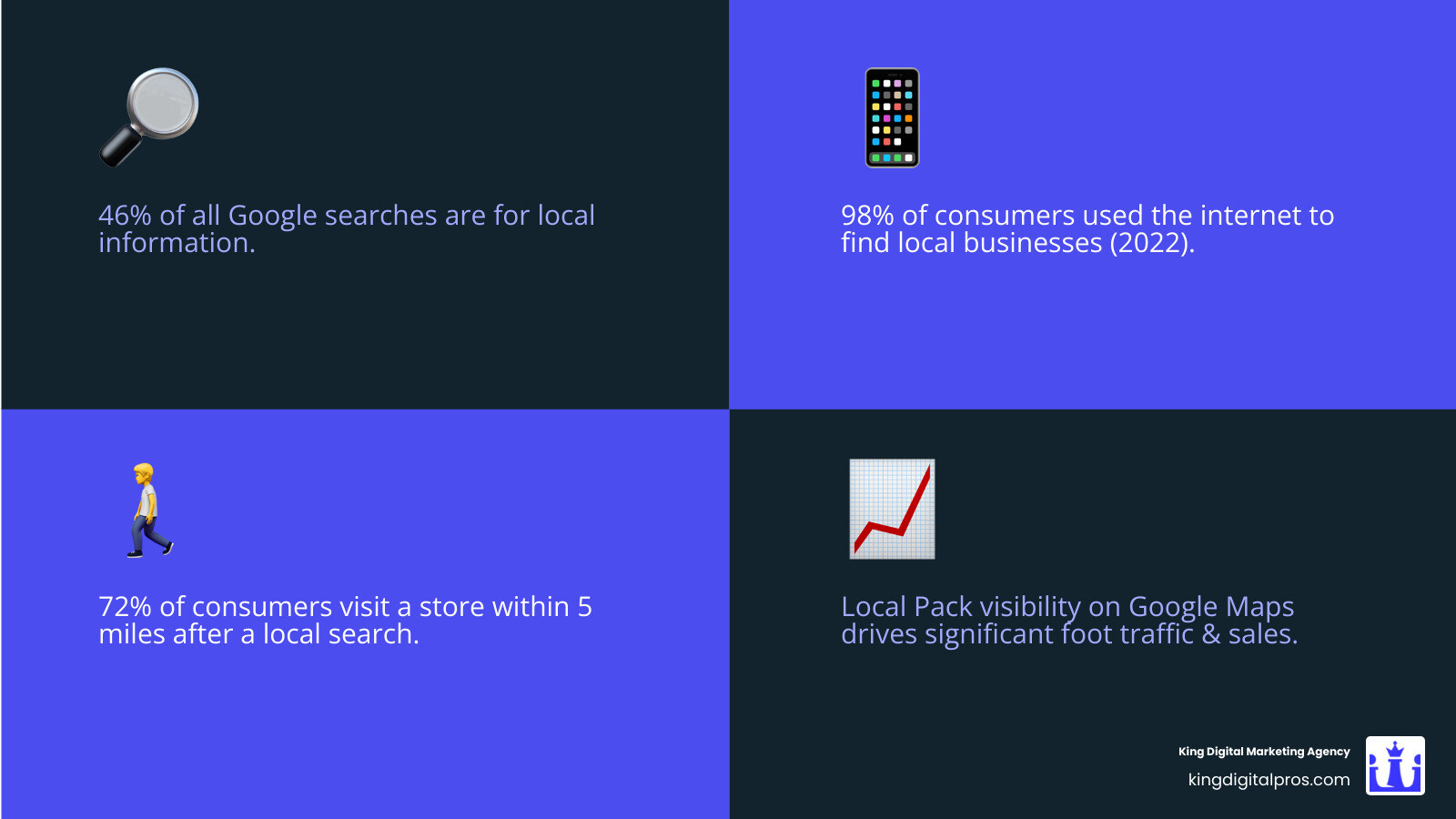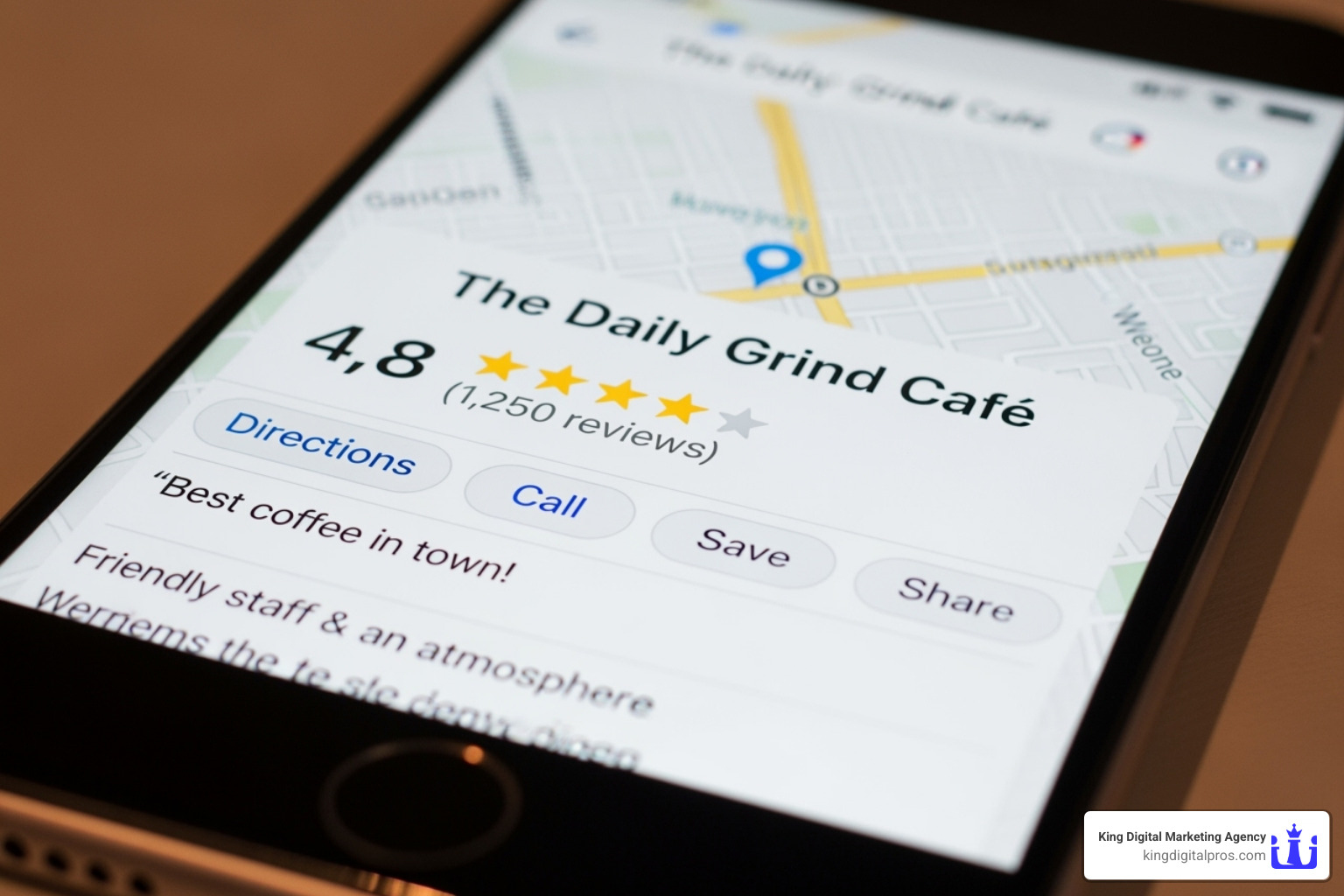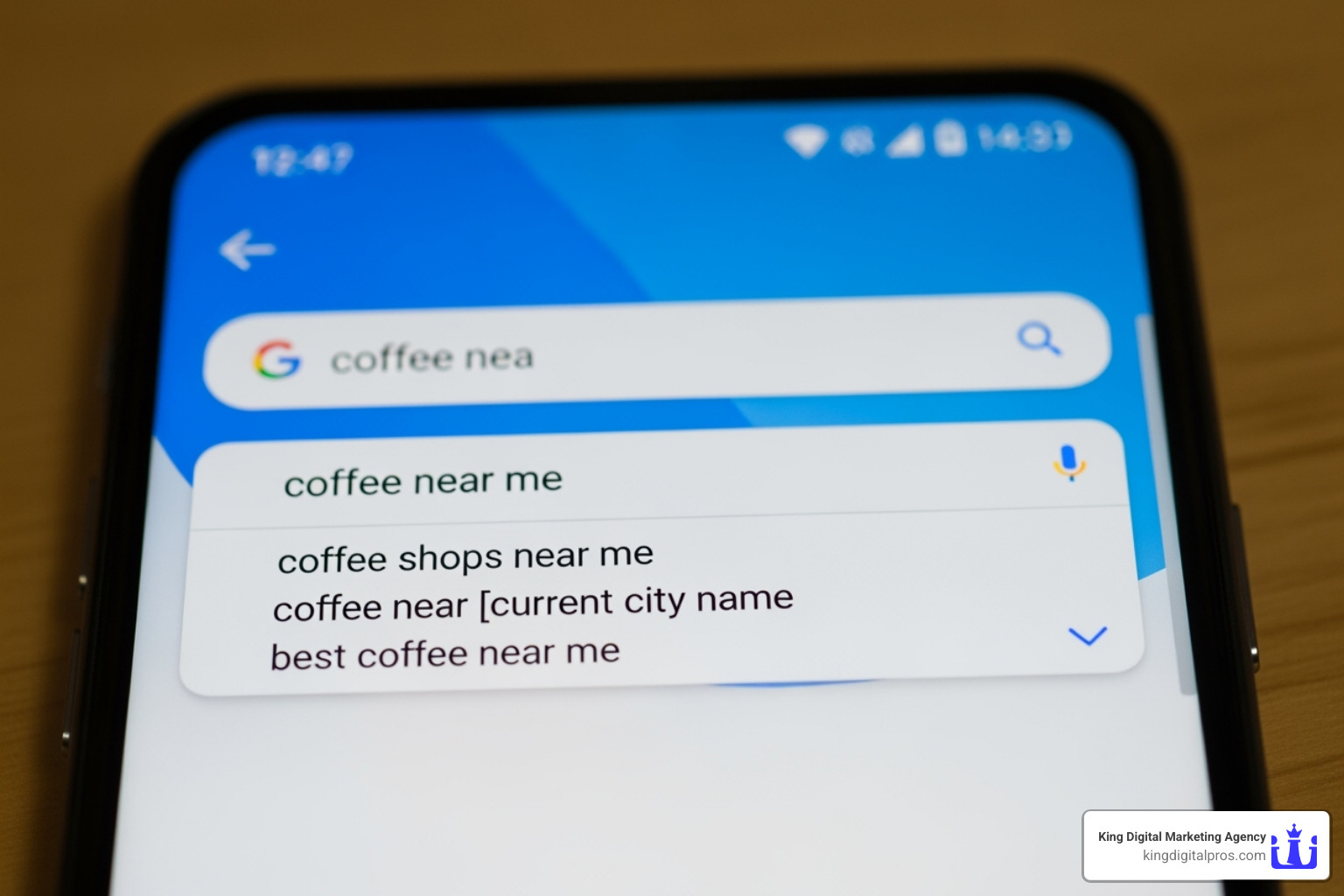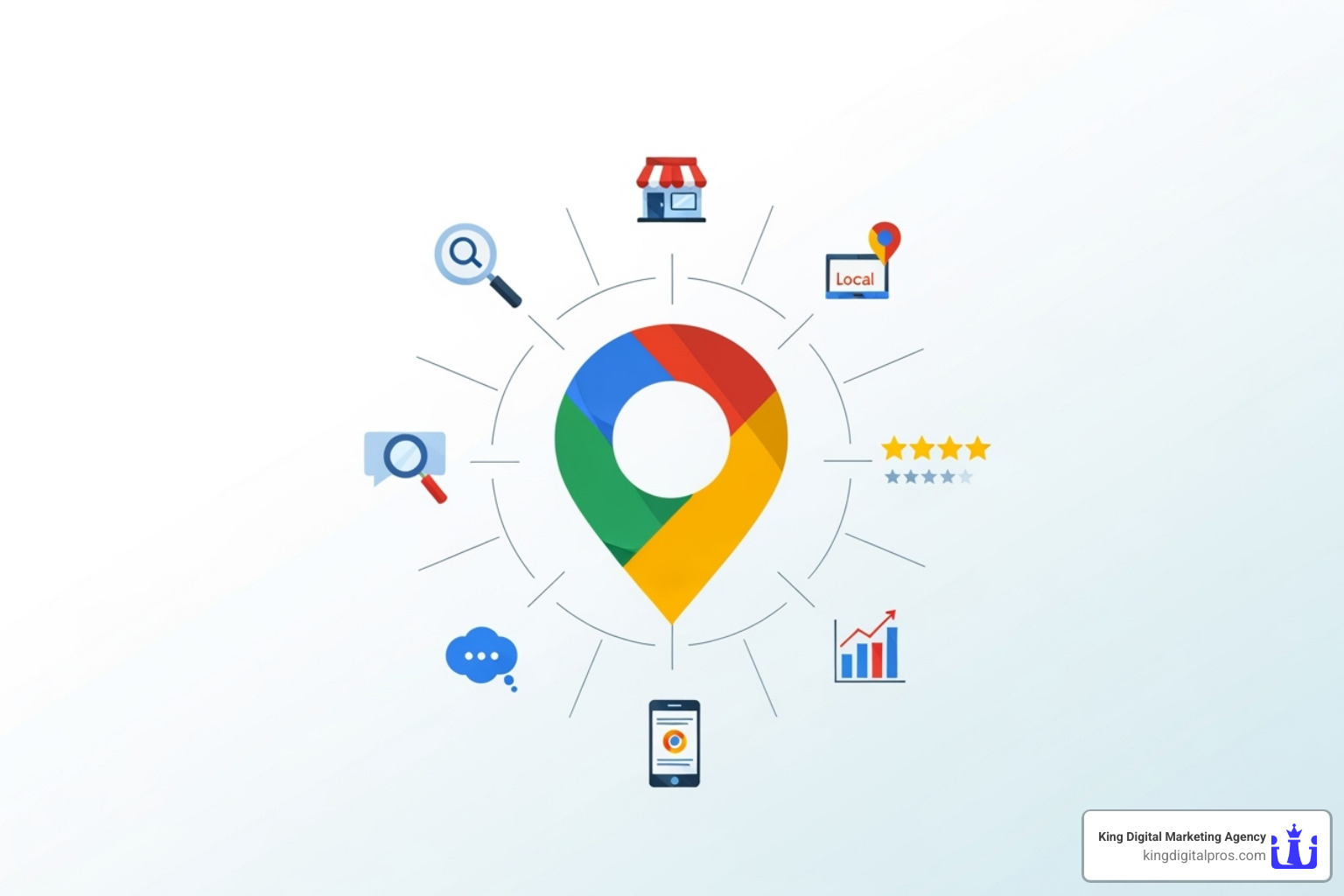Why Your Local Business Needs to Be on Google’s Radar
Google local search optimization is the process of making your business more visible in location-based search results. With 46% of all Google searches seeking local information, being visible means getting found by customers who are ready to buy.
When someone searches for “pizza near me,” Google displays a map with three businesses, known as the Local Pack. Getting into this prime digital real estate is crucial, as 72% of consumers visit a store within five miles after a local search. This visibility directly translates to foot traffic and sales.
Google’s local ranking algorithm focuses on three key factors:
- Relevance: How well your business matches the search query.
- Distance: How close you are to the searcher.
- Prominence: How well-known and trusted your business is.
I’m Bernadette King, founder of King Digital. I’ve helped hundreds of businesses master Google local search optimization. The most successful strategies are simple and consistent, focusing on building trust with both Google and your customers.

Your Digital Storefront: Mastering Your Google Business Profile
This is the foundation of your local presence. Think of it as your business’s free homepage on Google. We’ll walk through setting it up perfectly.
Claiming and Verifying Your Business Profile
First, you must claim or create your Google Business Profile (GBP). This is your digital “Open for Business” sign. After setup, you must verify your profile to prove you’re the legitimate owner. Google offers several methods, including a postcard with a code sent to your address, phone, or email verification. Verification is non-negotiable for full visibility. You can manage your business and find detailed guidance in the Google Business Profile Help section.
Filling Out Your Profile Completely: The Nitty-Gritty Details
A complete and accurate profile makes a better impression on customers and Google’s algorithm. Businesses with complete information are 70% more likely to attract customer engagement. Here are the essential fields:
- Business Name, Address, Phone Number (NAP): Your official, consistent business information. Use a local area code, like 505 for our New Mexico clients.
- Website: Your official website URL.
- Business Hours: Your regular and holiday hours. Keep them updated.
- Service Areas: For businesses that travel to customers (e.g., a plumber in Albuquerque NM), define the specific cities or regions you cover.
- Products & Services: List everything you offer in detail. Choose the most relevant primary and secondary categories from Google’s list of nearly 4,000.
- Attributes: Special features like “Wi-Fi available,” “wheelchair accessible,” or “women-led.”
- High-quality photos: Businesses with images get 42% more requests for directions. Add professional photos of your storefront, interior, products, and team.
- Business description: A concise, keyword-rich overview of what makes your business unique.
Keeping Your Profile Active and Engaging
An active profile signals to Google that your business is open and relevant. Here’s how to keep it vibrant:
- Google Posts: Use these mini-updates to announce new products, share events (like a market in Taos NM), or post special offers.
- Q&A feature: Proactively answer common questions and monitor new ones from customers to show you’re responsive.
- Messaging feature: Allow customers to send inquiries directly from your profile for quick lead conversion.
By keeping your profile complete and active, you provide a better experience for customers and satisfy Google’s algorithm, which is key to attracting customers via Google Maps.
The ‘Secret Sauce’: How Google Ranks Local Businesses
Google isn’t just randomly picking businesses. It uses a specific recipe to decide who shows up first. Understanding these three main ingredients is key.
Google’s local search algorithm uses three main factors to rank businesses: Relevance, Distance, and Prominence. Mastering these is the key to local search success.
Ingredient 1: Relevance
Relevance is how well your business matches a search query. If someone searches for an “Italian restaurant,” Google aims to show them Italian restaurants. Optimizing for relevance involves several factors:
- Matching Search Queries: Use the right keywords naturally throughout your profile and website. Avoid keyword stuffing.
- Business Categories: Your primary category (e.g., “Pizza Restaurant”) is your most important declaration to Google. You can add up to nine secondary categories (e.g., “Wing Joint,” “Bar”) to broaden your reach for different searches.
- Services: Detail every service you offer. A plumber might list “drain cleaning” and “water heater repair.” The more specific you are, the more searches you can match.
- Profile Content: Google analyzes your entire profile, including your description and photos, to understand your business.
For more details, you can read about how Google determines relevance directly from the source.
Ingredient 2: Distance (or Proximity)
This factor is straightforward: how far is the searcher from your business? Google prioritizes results that are truly local.
- User’s Location: Google uses the searcher’s device location to determine proximity. A search for “coffee shop” will show the nearest options.
- Specified Location: If a user searches “pizza in Brooklyn,” Google uses that specified location instead of the user’s current position.
- “Near me” searches: These high-intent queries have increased by 250% since 2017 and signal an immediate need.
- Service Area Businesses (SABs): For businesses without a storefront, like a mobile mechanic, distance is calculated from the center of your defined service area.
Ingredient 3: Prominence
Prominence refers to how well-known and reputable your business is. Google looks for online signals that your business is established and respected.

- Online Reviews: The quantity, quality, and velocity of your reviews are critical. Review signals make up to 15 percent of Google’s local ranking factors, and 77% of consumers read reviews before choosing a business.
- Star Ratings: A high average star rating signals quality and customer satisfaction.
- Backlinks: Links from other reputable websites act as votes of confidence, boosting your authority.
- Citations: Mentions of your Name, Address, and Phone number (NAP) on sites like Yelp and Yellow Pages confirm your business’s legitimacy. Consistency is crucial.
- Website Authority: A well-optimized, secure, and informative website contributes significantly to your prominence.
Improving these three factors is the core of Google local search optimization. For help boosting your online reputation, consider dedicated Reputation Management Services.
Beyond Your Profile: Essential Google Local Search Optimization Tactics
A great profile is step one. To truly dominate local search, you need to send Google signals from all over the web that your business is the real deal.
The Power of Online Reviews
Online reviews are digital word-of-mouth, providing social proof for customers and powerful ranking signals for Google. According to studies on review signals as a ranking factor, they make up a significant portion of local rankings.
- Encourage Reviews: Simply ask satisfied customers for a review. Use QR codes, email follow-ups, or a link on your website to make it easy.
- Respond to All Reviews: Engage with both positive and negative feedback. Thank happy customers. For negative reviews, respond professionally, apologize if needed, and offer to resolve the issue offline. This shows you value customer feedback.
- Manage Negative Reviews: Don’t ignore them. Acknowledge the issue and offer a solution. This can mitigate damage and demonstrate good customer service.
- Review Velocity: A steady stream of new reviews signals that your business is active and consistently satisfying customers.

Building Trust with Local Citations and NAP Consistency
Citations are online mentions of your business’s NAP (Name, Address, Phone Number). They help Google confirm your legitimacy.
- Consistency is Everything: Your NAP must be identical everywhere – on your GBP, website, and all directories like Yelp or Bing Places. Even minor differences (“St.” vs. “Street”) can confuse Google and harm your rankings.
- Audit and Clean Up: Regularly audit your citations to find and fix inconsistencies, especially after moving or changing your phone number. Consistent NAP data can significantly improve your chances of appearing in the local pack. Avoid common myths about Google Map listings that often stem from NAP issues.
On-Page SEO: Tuning Up Your Website for Local Success
Your website is a key part of Google local search optimization. Google uses it to assess your prominence and relevance.
- Performance: Your site must be fast and mobile-friendly. Google uses mobile-first indexing and prioritizes sites that load quickly, as measured by metrics like Core Web Vitals.
- Localize Your Content: Create content that speaks to your local audience. For businesses with multiple locations, create unique location pages with specific NAP information and descriptions.
- Optimize Key Elements: Use local keywords in your title tags, meta descriptions, headings, and website copy. For example, “Best HVAC Repair in [Your City].”
- Internal Linking: Link relevant pages within your site to help Google understand its structure and improve user experience.
For a complete approach, consider comprehensive SEO services that cover all these aspects.
Effective Strategies for Local Link Building
Backlinks from local and relevant sources are powerful signals of authority. Quality is more important than quantity.
- Community Involvement: Sponsor local events or partner with other local businesses to earn valuable links and exposure.
- Local Media: Reach out to local news outlets or blogs with a newsworthy story to get featured.
- Guest Posting: Write a helpful article for a local blog to share your expertise and get a link.
- Directories: Join your local Chamber of Commerce and list your business in relevant industry directories.
Finding Your Customers & Measuring Your Success
Optimization is great, but how do you know it’s working? Here’s how to find the right search terms and track your progress.
Simple Local Keyword Research
Understand what your customers are searching for to optimize effectively. This means getting inside their heads.

- High-Intent Keywords: Focus on terms that show immediate need, like “near me” keywords (“plumber near me”) and service + city combinations (“HVAC repair Santa Fe NM”).
- Use Google’s Tools: Use Google Autocomplete by typing a service into the search bar to see what real queries people use. For deeper insights, Google’s Keyword Planner provides search volume data for local keywords.
- Think Like a Customer: Consider variations, synonyms, and long-tail keywords (longer, more specific phrases like “affordable vegan restaurant with outdoor seating”). These often have high conversion rates.
Understanding localized search patterns in areas like Taos NM or Tijeras NM is key to attracting relevant customers.
Monitoring Your Local SEO Performance
Tracking performance is your Google local search optimization report card. It shows what’s working and what isn’t.
- Google Search Console: This free tool shows which local keywords you’re ranking for and helps you spot technical issues. Use Google Search Console to monitor your website’s health in search.
- GBP Insights: Your Google Business Profile dashboard shows how customers find and interact with your listing, including views, calls, website clicks, and direction requests.
- Track Key Metrics: Monitor your rankings for important local keywords and track your position on Google Maps from different points in your service area. This helps you understand how proximity affects your visibility.
By reviewing these metrics, you can make data-driven decisions to refine your strategy. For businesses looking to capture high-intent leads directly, we also help manage Google Local Service Ads.
Frequently Asked Questions about Google Local Search Optimization
How long does it take to see results from local SEO?
Google local search optimization is a marathon, not a sprint. While some changes like updating your business hours are instant, climbing the rankings takes time. You can typically expect to see meaningful movement in 3-6 months.
Factors like your industry’s competitiveness and your location play a big role. A plumber in a small town may see results faster than a dentist in a major city. The most important factor is consistency – regularly updating your profile, gathering reviews, and ensuring your information is accurate will lead to better, faster results.
Can I pay Google to rank my business higher in local search?
No. You cannot pay for a better organic ranking in the Local Pack or on Google Maps. Google’s official policy states there is “no way to request or pay for a better local ranking.” Those spots are earned through relevance, distance, and prominence.
However, you can pay for ads. Google Ads and Local Service Ads appear separately from organic results and are clearly marked as paid placements. A good strategy often involves using paid ads for immediate visibility while building your long-term organic presence through local SEO.
Do I need a physical storefront to show up in local search?
Not necessarily. Service Area Businesses (SABs) – like plumbers, contractors, or mobile groomers who travel to their customers – can thrive in local search.
Instead of a physical address, you define a service area (e.g., “Greater Albuquerque area” or specific zip codes). Your business will still appear in local search results for people within that area, without revealing your home address. While Google’s algorithm can sometimes favor businesses with physical storefronts, SABs can achieve excellent visibility by clearly defining their service areas and optimizing their online presence just like any other business.
Conclusion: Turn Local Searches into Loyal Customers
Mastering Google local search optimization is one of the most powerful actions you can take for your business. By focusing on Google’s core ranking factors – relevance, distance, and prominence – you can capture a steady stream of nearby customers who are ready to buy.
The beauty of local SEO is that it levels the playing field. A small, local business that actively manages its online presence can often outrank a large national chain that neglects its local listings. The key is treating local SEO as an ongoing investment, not a one-time task.
Every day, people in your area are searching for what you offer. The question is: will they find you or your competition? With 72% of consumers visiting a store within five miles after a local search, the payoff for being visible is real foot traffic and revenue.
If you’d rather have an expert handle it, the team at King Digital Marketing Agency can help you dominate your local market. We specialize in optimizing Google Business Profiles to improve visibility and attract more customers. Explore our comprehensive SEO services to get started.


